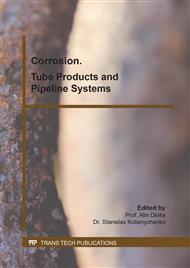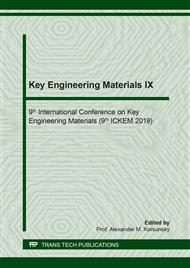p.280
p.287
p.294
p.301
p.307
p.313
p.321
p.327
p.337
Electrochemical Study of Calcareous Deposit Formation in Simulated Soil Solution under Cathodic Protection
Abstract:
Cathodic protection induces the formation of a calcareous layer has been shown to improve metal protection against corrosion by reducing the oxygen diffusion on the metal surface. The present study focuses on the electrochemical scaling induced by the application of cathodic polarisation. A combination of non-invasive in-situ electrochemical techniques and electrochemical impedance spectroscopy was used. Metal/electrolyte interface behaviour was studied using voltammetry to determine the controlling anodic and cathodic reactions. One-week long experiments were conducted. Applied potential –1.2 VSCE was shown to enable the formation of CaCO3 allotropes calcite and aragonite, and brucite due to increased interfacial pH which resulted in the formation of hydrogen at the electrode surface. Time constants from bode plots for applied potential –1.2 VSCE also illustrated the inhomogeneity of the calcareous layer. Modelling of polarisation curves illustrated a “passivation” phenomenon which resulted from formation of hydroxyl cations. This was further validated by bode plots with the added information on the diffusion reaction process. High frequency behaviour showed a steady increase in the electrolyte resistance which may be attributed to the formation of the calcareous layer. Evidence of the initial Mg-gel porous layer, which precedes the formation of brucite, was found.
Info:
Periodical:
Pages:
307-312
Citation:
Online since:
September 2019
Keywords:
Price:
Сopyright:
© 2019 Trans Tech Publications Ltd. All Rights Reserved
Share:
Citation:



